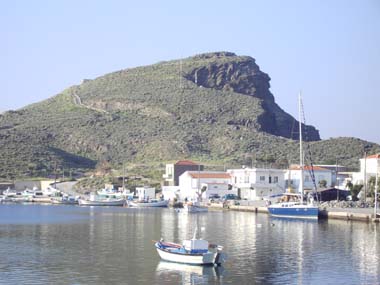|
Galana River II Log book of Sardinia, Greece and Turkey trip |
On Saturday 29th April, at 6.30 am, we left Patras and turned east to go under the beautiful, new modern bridge at Steno Rion, spanning the narrow entrance to the Corinthian Sea. There was a bit of trepidation for the mast as we passed under, but we got through unscathed.
The sea became flat calm as we proceeded, appearing more like a lake and in fact reminded me more of Lake Geneva in Switzerland, with neat little villages, green hills and snow-capped mountains in the background - no traffic in the water, no boats at all - it was very peaceful and serene. Only later did we encounter a couple of ships.
All the Greek coastline seen so far, has been sparsely populated, with steep mountains dropping down to the sea and with very little agricultural land available, confirming the necessity of the ancient Greeks to seek new lands, sending them far afield to colonise southern Italy, Calabria, Sicily and Sardinia. Necessarily they had to become good sailors and learn, or invent, the art of navigation. They returned with hair-raising stories of their adventures, which were collected and reassembled by Homer in the Odyssey of Ulysses. In fact we passed by the island, Ithaca, which I plan to visit on my way back next year and pay homage to this "father of all sailors".
I woke up from a snooze to find the indefatigueable Luigi tightening up my shrouds and looking up, we noticed that the radar reflector has gone, probably lost in that last storm. We must replace it immediately, before the next night crossing.
After a lazy motor we reached the city of Corinth, a sloppy town, that does not live up to the glory of its past, having been destroyed in an earthquake, as with many towns in the Greece and re-built in a hap-hazard way. We insisted with the port authorities in mooring in the commercial harbour, as the charts give the yacht harbour as insufficient for my 2.20 draft, but on closer look, I judged that we should have made it, but only near the entrance and only for few boats. The marina is very small. I hoped to re-fuel and stock up on stores and get a radar reflector, but all was closed, for Greek Orthodox Easter, which is a long-lasting affair, as I was to find out.
At dawn Sunday we set off for the Canal crossing, quite an extraordinary experience. We we were the only ones there. The magic wore off when I had to pay the bill at the other end, 160 Euro, but it was well worth paying for an unforgettable experience.
The following stops were Vouliagmeni, near Athens, where we had to call in for fuel. But we were caught up in an unending Easter celebration that went on for days, with everything commercial closed, except for restaurants, pubs and night-clubs. Vouliagmeni is an upmarket resort, where wealthy Athenians keep their yachts. After a few days we managed to find a taxi driver agreeable to ferry us and our drums to the only open petrol station in the area, so we managed to fuel up. But as we were about to leave, the local police objected to our being without Greek transit documents. Apparently they were not yet aware that Greece had become a European member, so I had to go through the whole rigmarole (with the most prettiest policewomen I have ever seen).
Once underway, we encountered a stunning ancient Greek temple dominating the sea from the top of a cape, Seunion.
From there we proceeded with some trepidation to the hazardous passage between the islands of Euboia and Andros, where the Meltemi can whip up a mountainous sea. But being familiar with the Strait of Bonifacio, I took courage in thinking that it could not be any worse. However the weather was favorable and we proceeded comfortably under power, the only incident being and abrupt stop with the prop being fowled by an enormous wad of compact rope. Young Marco volunteered to dive into the cold water and free it. At first stop I resolved will get an underwater torch, as it would have been big trouble had it happened in he dark, being without one.
At dawn we entered the delightful little island of Psara, with its sleepy and quaint fishing village.
Here we celebrated our landfall with a lobster lunch. After many photos and a watercolour painting spell, we sadly moved on to Mitilini on Lesbos. This is a much larger island, with an important capital city, though very attractive. Here we are just across the water from the arch-enemy, Turkey, so police and customs control and bureaucracy are very severe, sending you from one office to another, then back again.
Our last leg
was to cross over to Turkey, changing courtesy and customs flag on the way
and arriving finally in Ayvalik, after two weeks and 1000 miles from
Sardinia.
After leaving the boat for a long break and the installation of a holding tank, I returned with wife Mabi and cruised lazily down the Turkish coast, stopping at
Foca, Cesme,
Sigacik and
Kusadasi. We left the boat there and returned in August,
with Pierreandre' and family, to slowly sail down to
Bodrum, where we left
the boat for winter.
The following year Mabi and I returned several times, twice joined by friends, to continue the adventure and the discovery of the most amazing places: Cleopatra's Beach in the Gulf of Gokova, Gumusluk, Yalikavak, Torba, Bozburun, Marmaris, Fetiyie, Gocek and a myriad of islands and small sheltered coves, with good, simple restaurants and gentle hospitable people.
The history is overwhelming, with abandoned Greek and Romans ruins almost everywhere: Efesus, being the most renowned, Miletos, Priene, Pergamon, Iassus, Didyma, Knidos and many more.
A Mediterranean Cruising
Sailboat
Copyright L. Camillo 2006
